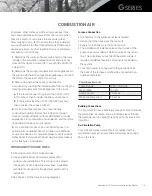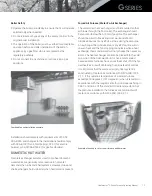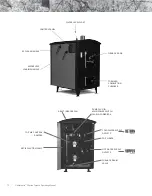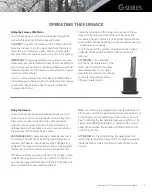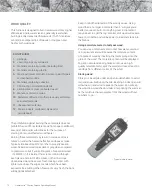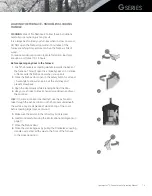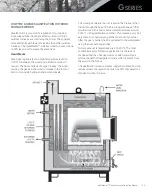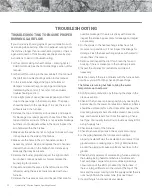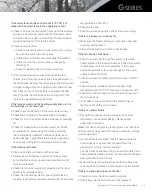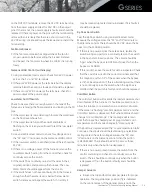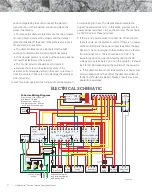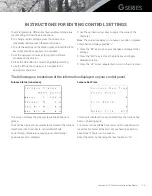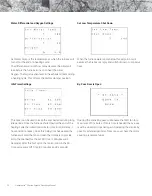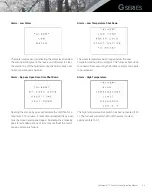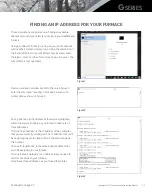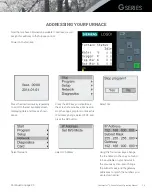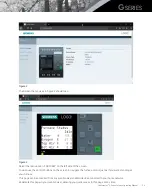
23
Heatmaster
ss
G Series Furnace Operating Manual
TROUBLESHOOTING TO ENSURE PROPER
BURNING & AIR FLOW
If your furnace is showing signs of poor combustion such
as smoking while burning, little to no exhaust coming from
the chimney, longer than normal heating cycles, or there is
a general concern of functionality, use these step by step
instructions to assist in troubleshooting.
•
Is the control calling for heat? Status = Heating Cycle/
Cold Start Mode. See the Control Settings section of this
manual.
•
Is the draft fan running in the rear cabinet? If not consult
the Draft Fan troubleshooting section in this manual.
•
In the rear cabinet, inspect the top and bottom air
dampers to ensure they are opening and closing as
indicated by the control. If not, refer to the actuator
troubleshooting section.
•
Use a light piece of paper (like receipt paper) and hold
it up to the openings in the damper plates. The paper
should be drawn to the openings. If it is not, there is an
airflow issue in the furnace.
•
Remove the top and bottom air box covers and inspect
for blockage. Use receipt paper to check for air flow in the
top and bottom air ducts. If there is not a visible blockage
but there is not adequate aiflow in the ducts inspect the
air channels within the firebox.
•
Make sure the ash bed is not so high as to block air holes
in the panels on the sides of the firebox.
•
Make sure the holes in the air channels are clear. If
necessary, remove, clean, and replace the air channels.
Inspect the burn slot in the firebox floor. Remove any
blockage that may be present.
•
Remove the burner plug and inspect the right and left
burn tubes. Clean as necessary. Always replace the
burner plug for operation.
•
Inspect and clean the areas to the left and rear of the
refractory using the service tools provided with your
furnace.
•
Remove the flue access cover and inspect that area for
possible blockage. If the area is sticky with creosote
inspect the smoke by-pass plate for leakage and adjust
as necessary.
•
Do the spirals in the heat exchange tubes have full
movement up and down? If not inspect the linkage for
damage. Flush the heat exchanger tubes with water to
loosen them if necessary.
•
Remove and inspect the draft fan. Clean the fan and
housing if there is creosote or other build up present.
•
Inspect the chimney for restrictions and clean if
necessary.
More than likely, if there is a problem with the furnace burn
or air flow, you will find it by checking these things.
The furnace is running but fails to bring the water
temperature up to setpoint:
•
Confirm good combustion by following the steps in the
previous section.
•
Check if the furnace is properly gasifying by opening the
bottom door to the Lower Combustion chamber. A flame
should be visible only for a short time after opening the
door and glowing embers should be present. Keep arms,
legs, and head at least 3 feet from the opening. Check
fuel type. Poor quality fuel will not provide as many BTU’s
as high-quality fuel.
•
Check water level of the furnace.
•
Check to ensure all pumps in the system are running.
•
Is the piping between the furnace and buildings
properly insulated? Has the insulation become wet from
groundwater or a leaking pipe or fitting? Wet insulation
around the piping will cause significant heat loss to the
ground.
•
Check the temperature of water exiting furnace, entering
the building being heated and before and after each
heat exchanger. Large temperature drops signal large
consumption of the BTU’s produced by the furnace. If
there is a large difference in the water at the top of the
tank and the water coming from the supply outlet there is
not enough flow in the water tank. (See next topic).
•
If everything is functional call your dealer.
TROUBLESHOOTING


